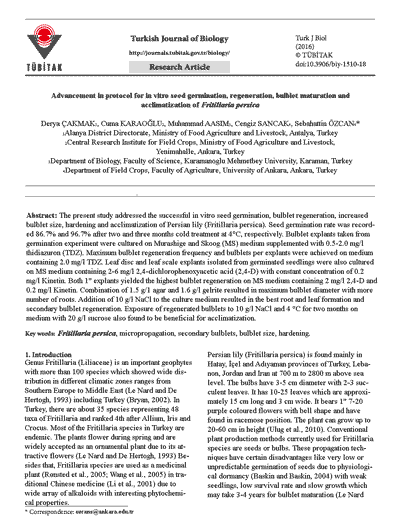NEWS 2016
Advancement in protocol for in vitro seed germination, regeneration, bulblet maturation and acclimatization of Fritillaria persica
Derya ÇAKMAK¹, Cuma KARAOĞLU², Muhammad AASIM³, Cengiz SANCAK⁴, Sebahattin ÖZCAN⁴
TURKISH JOURNAL OF BIOLOGY (2016)
doi: 10.3906/biy-1510-18
¹Alanya District Directorate, Ministry of Food Agriculture and Livestock, Antalya, Turkey
²Central Research Institute for Field Crops, Ministry of Food Agriculture and Livestock, Yenimahalle, Ankara, Turkey
³Department of Biology, Faculty of Science, Karamanoglu Mehmetbey University, Karaman, Turkey
⁴Department of Field Crops, Faculty of Agriculture, University of Ankara, Ankara, Turkey
Abstract
The present study addressed the successful in vitro seed germination, bulblet regeneration, increased bulblet size, hardening and acclimatization of Persian lily (Fritillaria persica). Seed germination rate was recorded 86.7% and 96.7% after two and three months cold treatment at 4°C, respectively. Bulblet explants taken from germination experiment were cultured on Murashige and Skoog (MS) medium supplemented with 0.5-2.0 mg/l thidiazuron (TDZ). Maximum bulblet regeneration frequency and bulblets per explants were achieved on medium containing 2.0 mg/l TDZ. Leaf disc and leaf scale explants isolated from germinated seedlings were also cultured on MS medium containing 2-6 mg/l 2,4-dichlorophenoxyacetic acid (2,4-D) with constant concentration of 0.2 mg/l Kinetin. Both 1" explants yielded the highest bulblet regeneration on MS medium containing 2 mg/l 2,4-D and 0.2 mg/l Kinetin. Combination of 1.5 g/1 agar and 1.6 g/l gelrite resulted in maximum bulblet diameter with more number of roots. Addition of 10 g/l NaCl to the culture medium resulted in the best root and leaf formation and secondary bulblet regeneration. Exposure of regenerated bulblets to 10 g/l NaCl and 4 °C for two months on medium with 20 g/l sucrose also found to be beneficial for acclimatization.




